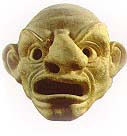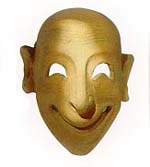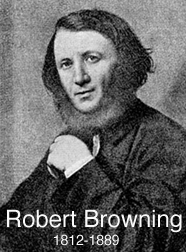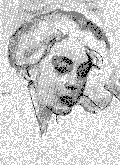Introduction to Literature, Spring 1999
Ray's
Syllabus
Kate's
Syllabus
British Victorian Poetry
 2. Where are the dramatic elements?
2. Where are the dramatic elements? |
Dramatic
Monologue
1. Are we the intended listener?
Dramatic Monologue Defined (
1) (
2)
|
 3. Is our life as dramatic or ironic?
3. Is our life as dramatic or ironic?
|

Browning's "My Last Duchess"
Questions for Group Discussion and Journal
Please read the questions in our textbook; they will help you think
more about the poem.
1. What you need to find out first, as the questions suggest, is the
"who, where, when, and why" of the poem--that is, who is speaking to whom
and at what time and for what purpose. Try to find out the role the listener
plays in this poem.
2. What is the last duchess like? (See ll. 21-34)
3. What is the duke's attitude to his duchess? (e.g. "Who'd stoop to
blame /This sort of trifling?" "E'en then would be some stooping; and I
chose never to stoop"; "This grew; I gave command; /Then all smiles stopped
together"; "There she stands/As if alive," etc.)
4. What does the ending reveal about the duke? For instance, the mentioning
of dowry, and "Neptune...taming a see-horse."
"Porphyria's Lover"
E-Text
-
The speaker, Porphyria's Lover, tells the story in a calm and steady
tone, though actually he has gone insane and killed Porphria. When do you
sense that the speaker is insane? Look for the various clues in his description
of Porphyria, their relationship, and his views about the killing.
-
Can you tell the story from Porphyria's perspective?
back
Robert Browning:
Relevant Links
 Browning--Overview
and Biography
Browning--Overview
and Biography
-
Robert
Browning Overview Page-- from the Victorian Web
-
Browning's
biography with some links to the Victorian Web and Browning's Poems.
-
Robert
Browning's biography from the Victorian Web
-
Elizabeth
Barrett Browning: An Overview A site about Browning'
wife, E. Barrett Browning, with links about her Themes, Imagery, Symbolism,
and Motifs, Genre and Mode , as well as in formation about cultural context.
 His Dramatic Monologue--
His Dramatic Monologue--
-
An
Introduction
-
3
definitions;
-
The
Figure of the Listener in Browning's Dramatic Monologues
-
Victorian
Reactions to Browning's Dramatic Monologues: " it was impossible to
make sense of his poetry, they said, he must have gone mad, he was unreadable
..."
 "My Last Duchess"
"My Last Duchess"
-
An
Introductory Essay to the poem "My Last Duchess"
-
The
Silent Listener in "My Last Duchess"
-
E-Text (Electronic Text): Introduction to Browning
and "My Last Duchess" --with a link to an interestingly printed
version of the poem.
 "Porphyria's
Lover"
"Porphyria's
Lover"
-
Student
Responses to "Porphyria's lover"
-
Student Responses to "Porphyria's Lover" and some other poems:
-
"Negative
Energy"--an essay on the characters in "Porphyria's Lover"¨:
back
"Ulysses"
Questions for Group Discussion and Journal
1. You, again, need to find out about the who, where, when and why of
the poem. The listener of the poem, however, might be hard to identify,
which makes the poem different from Browning's. Can you tell who the listeners
are?
2. How does Ulysses think about his present life (ll. 1-5), his past
experience (ll. 7-21), and what life should and should not be like (ll.
22-32). Why does Ulysses compare himself to "gray spirit" and "a sinking
star"?
3. What does Ullysses mean when he said "He works his work, I mine."
How does he distinguish his work from his son's?
4. Pay attention to a) the rhythm, b) the arrangement of explosive and
mellifluous sounds in the poem.
a) What are the effects of the monosyllables in ll. 1-5 and the use
of iambic pantameter (l. 5; ll. 22-25) in this stanza? How about the iambic
pantameter in the last line of the poem?
5. Pay attention to the use of mellifluous consonants (e.g. "m" "n" "l"
"r" "v" "f") and long vowels in the 2nd stanza (about Telemachus). Also
the shifting between explosives and short vowels on the one hand and mellifluous
consonants and long vowels on the other. What are the effects?
back
Tennyson:
Relevant Links
 Overview
and Biography
Overview
and Biography
-
Tennyson's
Biography and poems: with a flippant tone from Incompetech
which has British Authors Bigraphies
series and Artists series.
-
Tennyson:
An Overview: The Victorian Web's site on Tennyson
-
The Tennyson Page
a multimedia site with several of Tennyson's poems.
 "Ulysses"
"Ulysses"
-
Alfred
Tennyson's "Ulysses" presenting a number of views about "Ulysses"
back
¡@
"After Death"
E-Text
Questions for Group Discussion and Journal
-
When do you find out that the speaker is actually dead? Re-read the poem
with this awareness, what do you think about the speaker's tone? If you
find her calm, is it the same kind of calmness as that of Porphyria's lover?
-
What do you think about the speaker's attitudes toward the man who cries
for her?
-
What difference does it make if the man, the intended silent listener,
can hear the speaker?
Application & Wild Association

-
How is the theme of love and death differently in "Porphyria's Lover,"
"My Last Duchess," and "After Death"?
-
Compare the use of death in "After Death" with that in Emily Dickinson's
"I Heard a Fly Buzz When I Died."
back
Christina Rossetti: Relevant Links
 Overview and Biography
Overview and Biography
-
Christina
Rossetti: An Overview: from the Victorian Web
-
Christina
Rossetti in Context (contemporary views of her as a woman poet)
-
Image
and Symbol in Christina Rossetti's Poetry
-
Christina
Rossetti and the Visual Arts
 Views
on Death
Views
on Death
-
Death
As Release From Pain in Christina Rossetti's Works--View of death in
her poetry
-
"Deathbed
Scenes--Rossetti, Dickinson, and Sigourney "-- An Essay comparing/contrasting
death in Rossetti and Dickinson.
back
"The Farmer's Bride"
E-Text
Questions for Group Discussion and Journal
-
What is the dramatic situation in this poem? How is the farmer-speaker
related to his wife (e.g. stanzas 1, 3, 5)? What could be the possible
reasons for his wife's aloofness from and fear of human beings (e.g.
stanza 3)?
-
Stanza 4 has a vivid description of the winter scene which is not quite
like that of a farmer's. What's the function of this stanza?
Application & Wild Association

Dramatic Monologue
-
Among the five poems we read, only "My Last Duchess"
has a living and listening auditor on the scene. Why do the other
speakers speak if there is no (specific) listener?
-
What are the major differences between dramatic monologue
and lyric?
-
Some critic said that most of B. Springsteen's
songs, such as "Born in the U.S.A." and "I'm on Fire," are dramatic monologues.
Do you agree?
The Theme of Love
-
Are there some significant
differences between Robert Browning and the two female poets in their treatments
of love? To be more specific, you can compare the duke with
the farmer, "Porphyria's Lover" with "After Death."
 Overview
and Biography
Overview
and Biography
-
Mew's Biography
"Charlotte's poetry was distinctive for her development of dramatic monologue,
set to meter with a sharp sense of flow. Her lines often stretched
long and captured a sense of enthusiasm followed by restraint. The topics
often centered around loneliness, disillusionment, sexual longing, and
fear."
-
Charlotte Mew site-
the only extensive site about Mew, including her poems as well as introduction
to her Poetic Style,
Extensive
Bibliography, and the
publication background.
back
Links
about
Victorian Age
"The
Victorian Overview" from the Victorian Web constructed by George
Landow in Brown University.
pathetic
fallacy on the Victorian Web
the
grotesque on the Victorian Web
For Further Studies of the Victorian Age . . .
Please go to the
Historical Period Page in Fu
Jen English Literature Databank.
back to the top
Internet-Assisted
Course page


![]()